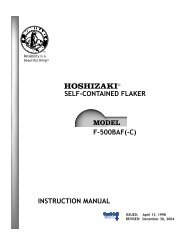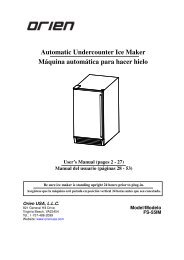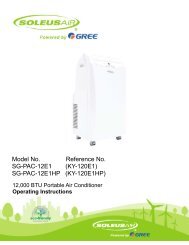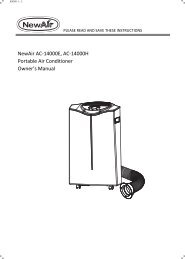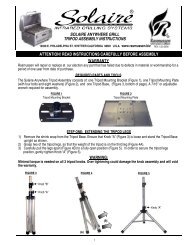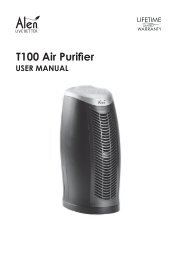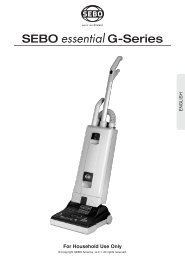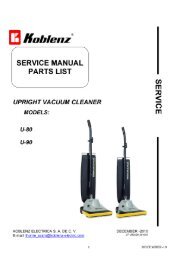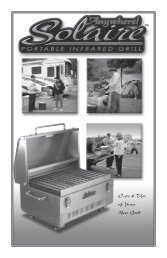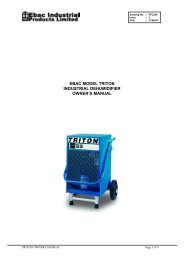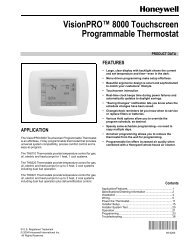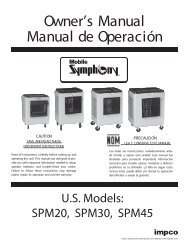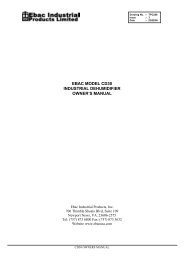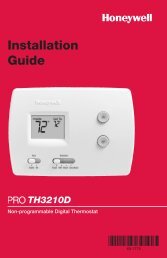68-0133 - Y8610U Intermittent Pilot Retrofit Kit - Air & Water
68-0133 - Y8610U Intermittent Pilot Retrofit Kit - Air & Water
68-0133 - Y8610U Intermittent Pilot Retrofit Kit - Air & Water
Create successful ePaper yourself
Turn your PDF publications into a flip-book with our unique Google optimized e-Paper software.
<strong>Y8610U</strong> INTERMITTENT PILOT RETROFIT KIT<br />
CHECKOUT<br />
Check out the gas control system:<br />
• At initial appliance installation.<br />
• As part of regular maintenance procedures. Maintenance<br />
intervals are determined by the application. See Planning<br />
the Installation section for more information.<br />
• As the first Troubleshooting step.<br />
• Anytime work is done on the system.<br />
<strong>68</strong>-<strong>0133</strong>—2<br />
WARNING<br />
FIRE OR EXPLOSION HAZARD<br />
CAN CAUSE PROPERTY DAMAGE,<br />
SEVERE INJURY, OR DEATH.<br />
1. If you smell gas or suspect a gas leak, turn off the<br />
gas at the manual service valve and evacuate the<br />
building. Do not try to light any appliance and do<br />
not touch any electrical switch or telephone in the<br />
building until no spilled gas remains.<br />
2. Perform the Gas Leak Test after initial Installation<br />
and anytime work is done to the gas piping.<br />
STEP 1: Perform a Visual Inspection.<br />
• With the power off, make sure all wiring connections are<br />
clean and tight.<br />
• Turn off all power to appliances and the ignition module.<br />
• Open manual shutoff valves in the gas line to the<br />
appliance.<br />
• Perform Gas Leak Test.<br />
WARNING<br />
FIRE OR EXPLOSION HAZARD<br />
CAN CAUSE PROPERTY DAMAGE,<br />
SEVERE INJURY, OR DEATH.<br />
Check for gas leaks with soap and water solution<br />
anytime work is done on a gas control.<br />
Gas Leak Test<br />
Paint all pipe connections upstream of the gas control<br />
with a rich soap and water solution. Bubbles indicate a<br />
gas leak.<br />
If a gas leak is detected, tighten the pipe connection.<br />
Stand clear while lighting the main burner to prevent<br />
injury caused from hidden gas leaks, which could cause<br />
flashback in the appliance vestibule. Light the main<br />
burner.<br />
With the main burner in operation, paint all pipe joints<br />
(including adapters) and gas control inlet and outlet<br />
with a rich soap and water solution.<br />
If another gas leak is detected, tighten the adapter<br />
screws, joints, and pipe connections.<br />
Replace the part if the gas leak cannot be stopped.<br />
STEP 2: Review Normal Operating Sequence and Module<br />
Specifications.<br />
• See Specifications and Operation sections.<br />
STEP 3: Reset the Module.<br />
• Turn the thermostat to its lowest setting.<br />
• Wait one minute.<br />
As you perform Steps 4 through 9, watch for points where<br />
operation deviates from normal. See the Troubleshooting<br />
Guide, Fig. 19, to correct the problem.<br />
12<br />
STEP 4: Check Safety Shutoff Operation.<br />
• Turn the gas supply off at the manual shutoff valve.<br />
• Set the thermostat or controller above the room<br />
temperature to call for heat.<br />
• Watch for spark at pilot burner.<br />
• Time spark from start to shutoff. See Specifications<br />
section.<br />
• Open the gas control knob and ensure no gas is flowing to<br />
the pilot or main burner.<br />
• Set the thermostat below the room temperature and wait<br />
one minute before continuing.<br />
STEP 5: Check and Adjust Gas Input to Main Burner.<br />
CAUTION<br />
1. Do not exceed the input rating stamped on the<br />
appliance nameplate, or manufacturer<br />
recommended burner orifice pressure for the size<br />
orifice(s) used. Make sure the main burner<br />
primary air supply is properly adjusted for<br />
complete combustion (see the appliance<br />
manufacturer instructions).<br />
2. If checking gas input by clocking the gas meter:<br />
• Make sure that the only gas flow through the<br />
meter is that of the appliance being tested.<br />
• Make sure that other appliances are turned off<br />
and that the pilot burners are extinguished (or<br />
deduct the gas consumptions from the meter<br />
reading).<br />
• Convert the flow rate to Btuh as described in<br />
the Gas Controls Handbook, form 70-6202<br />
and compare to the Btuh input rating on the<br />
appliance nameplate.<br />
3. If checking gas input with a manometer<br />
(pressure gauge):<br />
• Make sure the gas control knob is in the<br />
PILOT position before removing the outlet<br />
pressure tap plug to connect the manometer.<br />
• Turn the gas control knob back to PILOT when<br />
removing the manometer and replacing the<br />
outlet pressure tap plug.<br />
• Shut off the gas supply at the appliance<br />
service valve or, for LP gas, at the gas tank<br />
before removing the outlet pressure tap plug<br />
and before disconnecting the manometer and<br />
replacing the outlet pressure tap plug.<br />
• Perform the Gas Leak Test at the inlet<br />
pressure tap plug.<br />
The gas control output pressure should match the<br />
manifold pressure listed on the appliance nameplate.<br />
With the main burner operating, check the gas control<br />
flow rate using the meter clocking method or check the<br />
gas pressure using a manometer connected to the gas<br />
control outlet pressure tap. See Fig. 3.<br />
If necessary, adjust the pressure regulator to match the<br />
appliance rating.<br />
Gas control outlet pressure is normally set at 3.5 in. wc<br />
(0.9 kPa) nominal for natural gas. It can be adjusted<br />
from 3 to 5 in. wc (0.74 to 1.2 kPa).<br />
Gas control outlet pressure is normally set at 10 in. wc<br />
(2.5 kPa) nominal for LP gas. It can be adjusted from<br />
8 to 12 in. wc (2 to 3 kPa).<br />
a. Remove the pressure regulator adjustment cap<br />
and screw.<br />
b. Using a screwdriver, turn the inner adjustment<br />
screw clockwise to increase or counterclockwise<br />
to decrease the main burner gas pressure.<br />
c. Always replace the cap screw and tighten firmly.



